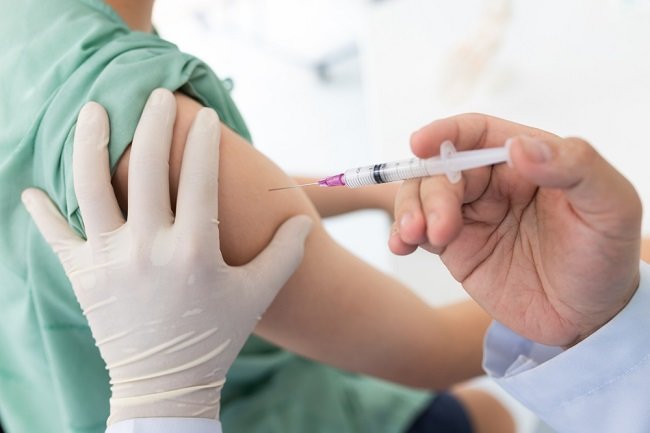A pulmonary embolism is a blockage in a blood vessel in the lungs. Blockages are usually caused by blood clots that initially form in other parts of the body, especially the legs.
In general, blood clots that form and cause pulmonary embolism are more than one. These blood clots will clog blood vessels and block blood flow to the tissues in the lungs, causing the death of lung tissue.

Pulmonary embolism is a serious and life-threatening condition for the sufferer. Therefore, prompt and appropriate treatment is needed to reduce the risk of complications and death.
Causes and Risk Factors for Pulmonary Embolism
Pulmonary embolism is most often caused by a blood clot from another part of the body blocking the pulmonary artery. Pulmonary arteries are blood vessels that carry blood from the heart to the lungs.
In the vast majority of cases, pulmonary embolism is caused by a blood clot that forms in deep vein thrombosis or deep vein thrombosis (DVT). DVT often occurs in the veins in the legs or pelvis. Blood clots from thrombophlebitis can also cause pulmonary embolism, but they are much less common.
In addition to blood clots, emboli in the pulmonary arteries can also be caused by other materials, such as:
- Air bubble
- Fat from broken bone marrow
- A collection of bacteria, fungi, or parasites
- Part of the tumor
- Amniotic fluid
There are several factors that can increase a person's risk of developing a pulmonary embolism, namely:
- Have had a pulmonary embolism, DVT, cancer, stroke, or heart attack
- Have had chemotherapy or surgery, such as bone, joint, or brain surgery
- Have a condition of not being able to get out of bed, for example due to paralysis or prolonged bed rest in the hospital
- Suffering from blood clotting disorders, being overweight (obese), or breaking bones, especially the thigh or hipbones
- Have a family history of pulmonary embolism
- Are undergoing hormone replacement therapy
- Are pregnant or have just given birth
- Are taking birth control pills
- Have a smoking habit
- Aged 60 years or older
Symptoms of Pulmonary Embolism
Symptoms of a pulmonary embolism can vary from person to person, depending on the extent of the lung affected, the size of the blood clot, and the condition of the heart and lungs. Some of the symptoms and signs that generally appear due to pulmonary embolism are:
- Shortness of breath that appears suddenly
- Chest pain that can radiate to the jaw, neck, shoulders and arms or chest pain that worsens when you breathe in (pleuritic pain)
- Coughing up phlegm or blood
- Dizziness or fainting
- Pain that can be accompanied by swelling in the legs, especially the calves
- Blue lips or fingertips (cyanosis)
- Fast and irregular heartbeat (arrhythmia)
- Back pain
- Excessive sweating
When to go to the doctor
Check with your doctor if you suddenly experience shortness of breath, chest pain, and coughing up phlegm that is accompanied by blood. These symptoms can be signs of pulmonary embolism and should be treated immediately.
Immediately see a doctor if you develop deep vein thrombosis (DVT). Blood clots in the legs due to DVT can travel to the lungs and cause a pulmonary embolism if not treated quickly.
Pulmonary Embolism Diagnosis
The doctor will ask about the symptoms experienced and the patient's medical history. After that, the doctor will perform a physical examination, including checking for signs of DVT.
To determine whether the patient has a pulmonary embolism, the doctor will perform tests, such as:
- Blood test, to measure D dimer (a protein in the blood that appears after a blood clot breaks down) and measures the levels of carbon dioxide and oxygen in the blood.
- Scan with duplex ultrasound, CT scan, ventilation-perfusion (V/Q) scan or MRI, to detect the position of blood clots in the body.
- Pulmonary angiography, or pulmonary angiography, to see blood flow in the pulmonary arteries. Pulmonary angiography is usually performed when other tests cannot confirm a pulmonary embolism.
Pulmonary Embolism Treatment
Pulmonary embolism treatment aims to prevent the formation of new blood clots and so that blood clots that have formed do not enlarge. There are several methods to treat pulmonary embolism, namely:
- Administration of anticoagulant drugs, to inhibit the formation of blood clots, and thrombolytic drugs to break blood clots.
- Insertion of a catheter, to prevent blood clots from entering the lungs. This procedure is intended for patients who should not be given anticoagulant drugs or who do not respond to anticoagulant drugs.
- Surgical embolectomy, to remove blood clots. This procedure is performed if the blood clot is too large and is life threatening for the patient.
Complications of pulmonary embolism
Although dangerous, pulmonary embolism can be cured. However, if treated too late, patients with pulmonary embolism can experience complications such as:
- A buildup of fluid in the membranes of the lungs (pleural effusion)
- High blood pressure in the arteries of the lungs (pulmonary hypertension)
- Lung tissue death (pulmonary infarction)
- Heart rhythm disturbances (arrhythmias)
- cardiac arrest
Pulmonary Embolism Prevention
One way to prevent pulmonary embolism is to prevent the occurrence of DVT (deep vein thrombosis). There are several things that can be done, namely:
- Do regular physical activity every day.
- Move your arms and legs every few minutes if you are on a long trip.
- Wear compression stockings if you can't move much because of bed rest.
- Maintain body fluid levels by drinking lots of water, and limiting the consumption of caffeinated drinks.
- Lower your weight to your ideal weight if you are obese.
- Stop smoking.









